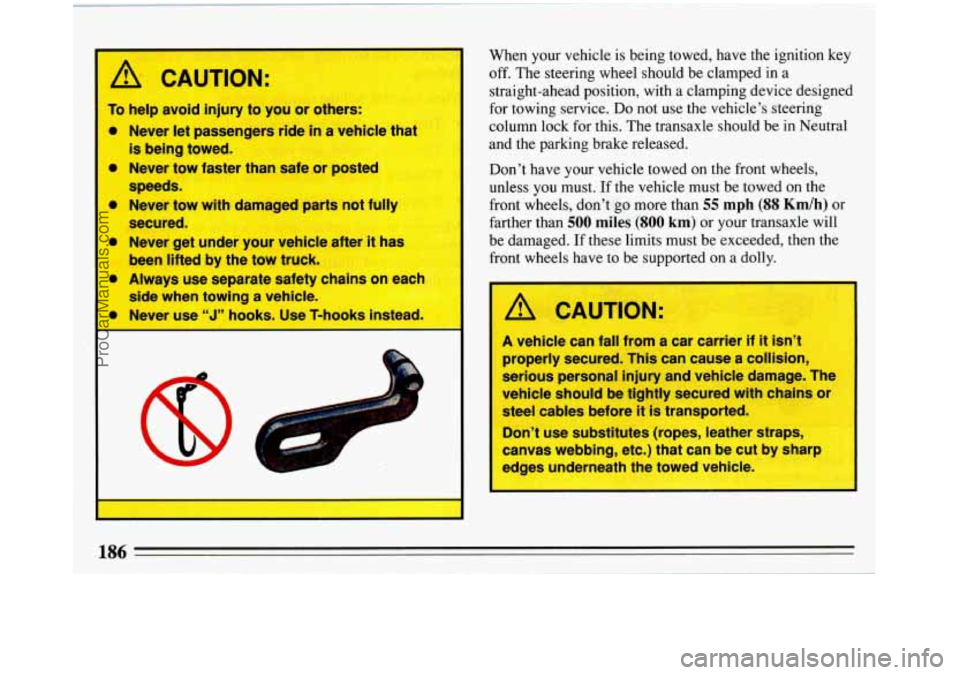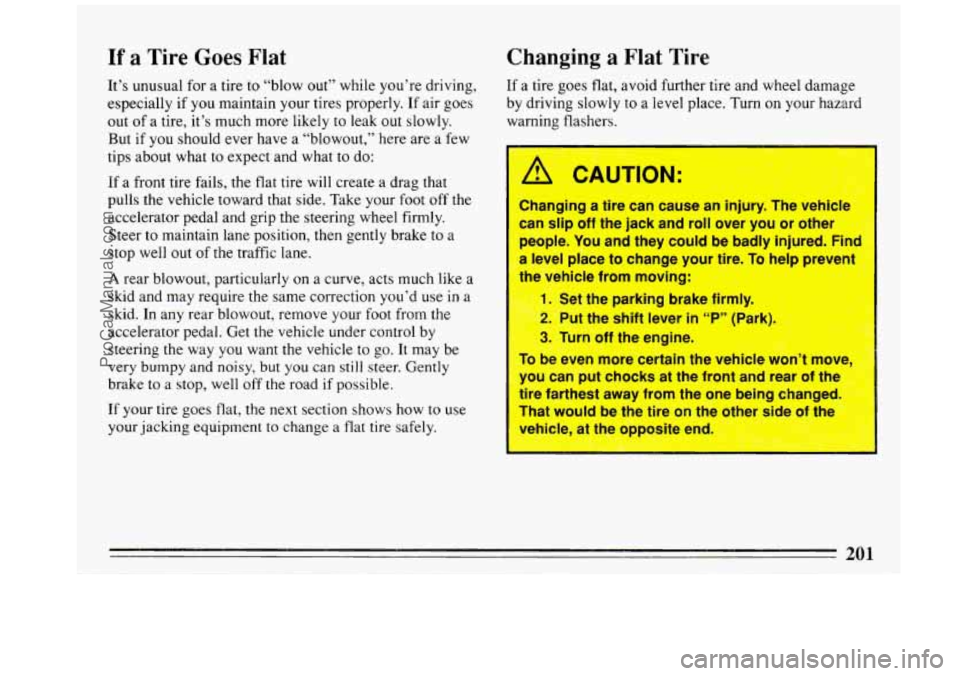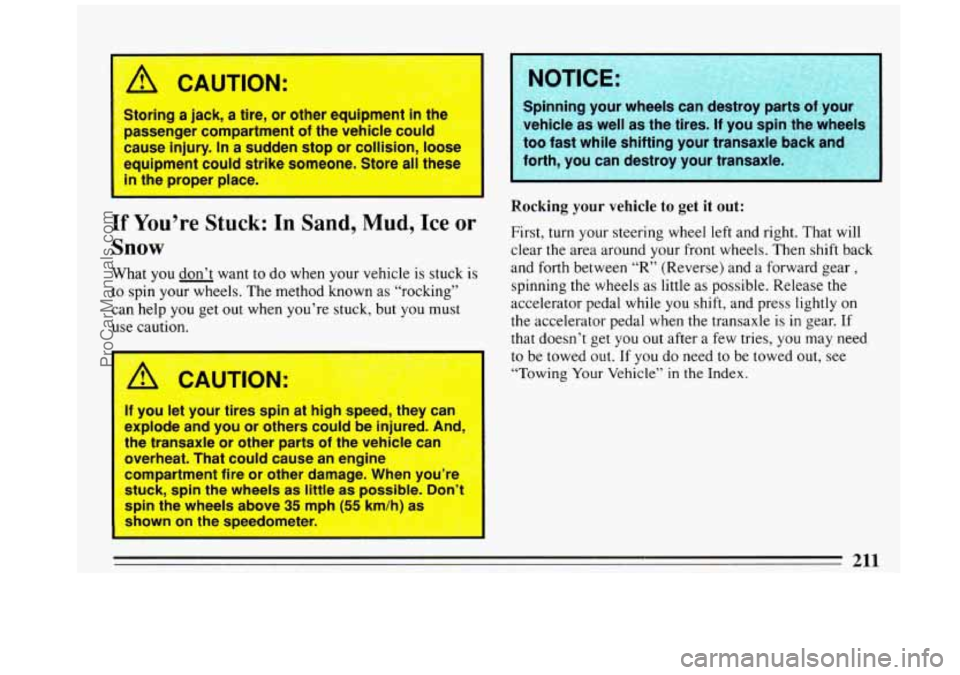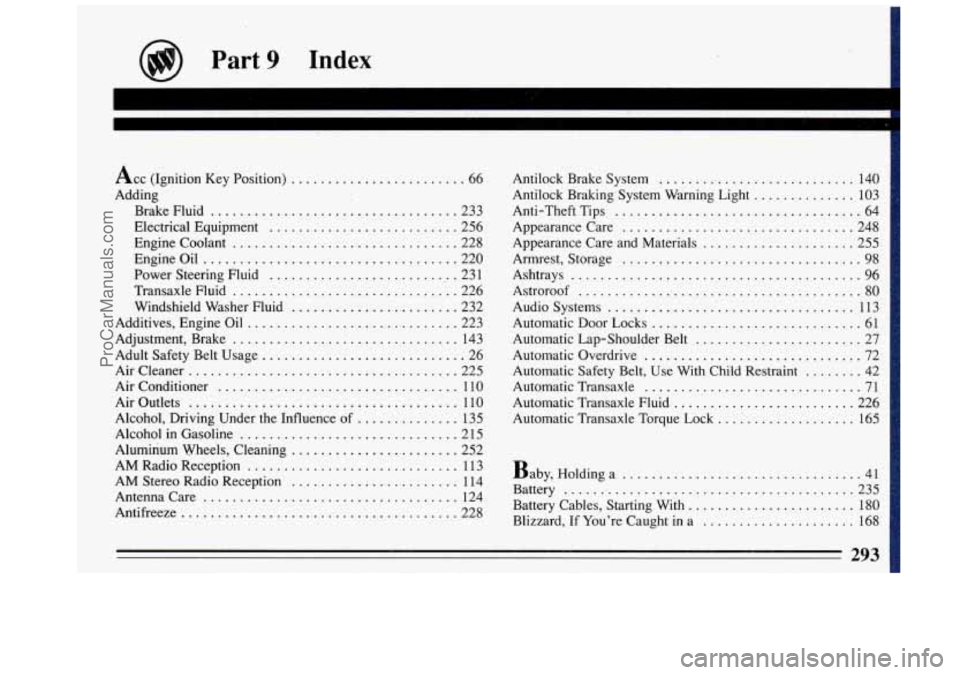1993 BUICK REGAL steering wheel
[x] Cancel search: steering wheelPage 188 of 308

0
0
0
0 0
0
'AA"TT
To help avoid injury to you or others:
Never let passengers ride
in a vehicle that
is being towed.
Never tow faster than safe or posted
speeds.
Never tow with damaged parts not fully
secured.
Never get under your vehicle after
it has
been lifted by the tow truck.
Always use separate safetv chains on each
side when towing
a vehic ~
Never use "J" hnnks- Use T-hanks i
When your vehicle is being towed, have the ignition key
off. The steering wheel should be clamped in a
straight-ahead position, with a clamping device designed
for towing service.
Do not use the vehicle's steering
column lock for this. The transaxle should be in Neutral
and the parking brake released.
Don't have your vehicle towed on the front wheels,
unless
you must. If the vehicle must be towed on the
front wheels, don't
go more than 55 mph (88 Km/h) or
farther than
500 miles (800 km) or your transaxle will
be damaged.
If these limits must be exceeded, then the
front wheels have to be supported
on a dolly.
/1 CAUTION:
A vehicle can fall from a car carrier if it isn't
properly secured. This can cause a collision,
serious personal injury and vehicle damage. The
vehicle should be tightly secured with chains or
steel cables before
it is transported.
Don't use substitutes (ropes, leather straps,
canvas webbing, etc.) that can be cut by sharp
edges underneath the towed vehicle.
186
ProCarManuals.com
Page 203 of 308

If a Tire Goes Flat
It’s unusual for a tire to “blow out” while you’re driving,
especially if you maintain your tires properly. If air goes
out
of a tire, it’s much more likely to leak out slowly.
But if
you should ever have a “blowout,” here are a few
tips about what to expect and what
to do:
If a front tire fails, the flat tire will create a drag that
pulls the vehicle toward that side. Take your foot off
the
accelerator pedal and grip the steering wheel firmly.
Steer
to maintain lane position, then gently brake to a
stop well out
of the traffic lane.
A rear blowout, particularly on a curve, acts much like a
skid and may require the same correction you’d use in a
skid. In any rear blowout, remove your foot fromthe
accelerator pedal. Get the vehicle under control by
steering the way you want the vehicle to go. It may be
very bumpy and noisy, but you can still steer. Gently
brake to a stop, well
off the road if possible.
If your tire goes flat, the next section shows how to use
your jacking equipment to change a flat tire safely.
Changing a Flat Tire
If a tire goes flat, avoid further tire and wheel damage
by driving slowly
to a level place. Turn on your hazard
warning flashers.
A CAUTION:
Changing a tire can cause an injury. The vehicle
can slip off the jack and roll over you or other
people. You and they could be badly injured. Find
a level place to change your tire. TO help prevent
be
! licle from moving:
. the parking brake firmly.
L. Put the shift lever in “P” (Park).
3. Turn off the engine.
To be even more certain the vehicle won’t move,
you can put chocks at the front and rear of
th
tire farthest away from the one being ehangec
That would be the tire
on the other side nG the
vehicle, at the
opposit- md. ;
201
ProCarManuals.com
Page 213 of 308

/;1 CAUTION:
I
Storing a jack, a tire, or other equipment in the
passenger compartment of the vehicle could
equipment could strike someone. Store
all the$$
in the proper place.
3use
injury. In a sudden stop or collision,
loose
!-
1
NOTICE:
Spinning your wheels can destroy parts of you1
vehicle
as well as the tires. If you spin the wheels
too fast while shifting your transaxle back and
forth, you
can destroy your transaxle
Aocking your vehicle to get it out:
If - You’re Stuck: In Sand; Mud’ Ice Or First, turn your steering wheel left and right. That will
Snow clear the area around your front wheels. Then shift back
What
you don’t want to do when your vehicle is stuck is and forth between “R” (Reverse) and a forward gear,
to spin your wheels. The method known as “rocking” spinning the wheels as little as possible. Release the
can help you get out when you’re stuck, but you must accelerator pedal while
you shift, and press lightly
on
use caution. the accelerator pedal when the transaxle is in gear. If
that doesn’t get
you out after a few tries, you may need
to be towed out. If you do need to be towed out, see
“Towing Your Vehicle”
in the Index.
IT you let your tires spin at h I speea, they can
explode and you or others could be injured. And
the transaxle or other parts of the vehicle can
overheat. That could cause an engine
compartment fire or other damage. When you’re
stuck, spin the wheels as little
as possible. Don’t
spin the wheels above
35 mph (55 km/h) as
shown on the speedometer.
211
ProCarManuals.com
Page 276 of 308

Explanation of Scheduled Maintenance
Services
Below are explanations of the services listed in Schedule
I and Schedule 11.
The proper fluids and lubricants to use are listed in
Section D. Make sure whoever services your vehicle uses
these. All parts should be replaced and all necessary
repairs done before
you or anyone else drives the vehicle.
NOTE: To determine your engine’s displacement and
code, see “Engine Identification” in the Index.
1. Engine Oil and Filter Change* -- Always use SG
Energy Conserving I1 oils of proper viscosity. The
“SG” designation may be shown alone or in
combination with others, such as “SG/CC”, ,“SG/CD”
or
“SF, SG, CC,” etc. To determine the preferred
viscosity for your vehicle’s engine (e.g., SAE 5W-30
or SAE 10W-30), see “Engine Oil”
in the Index.
2. Chassis Lubrication -- Lubricate the transaxle shift
linkage, parking brake cable guides, underbody
contact points and linkage. If your vehicle is
equipped with grease fittings, lubricate
the
suspension and steering linkage. 3.
Throttle Body Mounting
Bolt Torque* -- Check
the torque
of the mounting bolts and/or nuts.
4. Tire and Wheel Rotation and Inspection -- For
proper wear and maximum tire life, rotate your tires
following the instructions
in this manual. See “Tires,
Inspection
& Rotation” in the Index. Check the tires
for uneven wear or damage. If you see irregular or
premature wear, check the wheel alignment. Check
for damaged wheels also.
5. Engine Accessory Drive Belt(s) Inspection --
Inspect the belt(s) for cracks, fraying, wear and
proper tension. Replace as needed.
6. Cooling System Service* -- Drain, flush and refill
the system
with new or approved recycled coolant
conforming to GM Specification 1825M. Keep
coolant at the proper mixture as specified. See
“Coolant”
in the Index. This provides proper freeze
protection, corrosion inhibitor level and engine
operating temperature.
Inspect hoses and replace
if they are cracked,
swollen or deteriorated. Tighten screw-type hose
clamps. Clean the outside
of the radiator and air
* An Emission Control Service.
The
U.S. Environmental Protection Agency has determined that the failure to perform this maintenance item will not nullify the emission warranty or limit recall liability prior tothe completion of vehicle useful life. General Motors, however, urges that all recommended maintenance \
services he performed at the indicatcd intervals and the maintenance be recorded in ”Section E:Maintenance Record”.
274
ProCarManuals.com
Page 281 of 308

CHECK OR
I SERVICE WHAT TO DO
Underbody
Flushing At
least every spring, use plain water
to flush any corrosive materials from
the underbody. Take care to clean
thoroughly any areas where mud and
other debris can collect.
Section C: Periodic Maintenance
Inspections
Listed below are inspections and services which s ,hou !Id
be performed at least twice a year (for instance, each
spring and fall).
You should let your GM dealer’s
service department or other qualified service center do
these jobs. Make sure any necessary repairs are
completed at once.
INSPECTION
OR SERVICE
Steering,
Suspension and
Front-Wheel- Drive Axle
Boot and Seal
Inspection
Exhaust System
Inspection
Throttle Linkage
Inspection
WHAT SHOULD BE DONE
Inspect the front and rear suspension
and steering system for damaged, loose or missing parts, signs of wear,
or lack of lubrication. Inspect
the
power steering lines and hoses for
proper hookup, binding, leaks,
cracks, chafing, etc. Clean and then
inspect the drive axle boot seals for
damage, tears or leakage. Replace
seals
if necessary.
Inspect the complete exhaust
system. Inspect the body near
the
exhaust system. Look for broken,
damaged, missing or out-of-position
parts as well as open seams, holes,
loose connections, or other conditions which could cause
a heat
build-up
in the floor pan or could let
exhaust fumes into the vehicle. See
“Engine Exhaust”
in the Index.
Inspect the throttle linkage for
interference or binding, and for
damaged or missing parts. Replace
parts
as needed.
279
ProCarManuals.com
Page 295 of 308

Acc (Ignition Key Position) ........................ 66
Adding Brake Fluid
................................... 233
Electrical Equipment
.......................... 256
Engine Coolant
....................... i ....... 228
Engine Oil
.................................... 220
Power Steering Fluid
.......................... 231
Transaxle Fluid
............................... 226
Windshield Washer Fluid
....................... 232
Additives. Engine Oil
............................. 223
Adjustment. Brake
............... : ............... 143
Adult Safety Belt Usage
............................ 26
Aircleaner
...................................... 225
Airconditioner
................................. 110
Air Outlets
..................................... 1 10
Alcohol, Driving Under the Influence of
.............. 135
Alcohol in Gasoline
.............................. 215
Aluminum Wheels, Cleaning
....................... 252
AM Radio Reception
............................. 113
AM Stereo Radio Reception
........................ 1 14
Antenna Care
..................................... 124
Antifreeze
...................................... 228 Antilock Brake System
.......................... 140
Anti-Theft Tips
.................................. 64
Appearance Care
................................ 248
Appearance Care and Materials
....................... 255
Armrest. Storage
................................... 98
Ashtrays
........................................ 96
Astroroof
....................................... 80
Audio Systems
.................................. 113
Automatic Door Locks
............................. 61
Automatic Lap-Shoulder Belt
........................ 27
Automatic Overdrive
.............................. 72
Automatic Transaxle
.............................. 71
Automatic Transaxle Fluid
......................... 226
Automatic Transaxle Torque Lock
.. ; i : .............. 165
Antilock
Braking' System Warning Light
.............. 103
Automatic Safety Belt. Use With Child Restraint
........ 42
Baby. Holding a
.................................. 41
Battery
........................................ 235
Battery Cables. Starting With
....................... 180
Blizzard. If You're Caught in a
..................... 168
293
ProCarManuals.com
Page 302 of 308

Power Antenna Cleaning
............................. 124
DoorLocks
................................... 61
Mirrors
...................................... 94
Seat Controls
.................................. 15
Steering
..................................... 144
Steering Fluid
................................ 231
Windows
..................................... 79
Pregnancy. Use of Safety Belts During
................ 33
Pressure. Tire ................................... 241
Problems on the Road
............................ 177
Proper Safety Belt Usage. for Adults
.................. 26
Publications Order Form
.......................... 291
Publications. Service
............................. 288
Push-Starting Your Car
........................... 180
R (Reverse) Gear Position ......................... 71
Racing. Shifting When Your Engine is
................ 79
Radiator Pressure Cap ............................ 231
Radio. Two-way. Adding
a ........................ 1 14
Radio Systems
.................................. 1 13
Rain. Driving
in ................................. 152
Reaction Time
in Braking ......................... 139
Reading Lights
................................... 93
Rear Seat Console and Pass-Through
................. 98
Rear Window Defogger
........................... 113
Reclining Front Seatbacks
.......................... 16
Recommended Fluids and Lubricants
................ 280
Radiator Overheating ............................. 192 Recovery.
Off-Road
.............................. 146
Recreational Vehicle. Towing
a ..................... 170
Remote Keyless Entry System
....................... 62
Remote Trunk Release
............................. 61
Replaceable Light Bulbs .......................... 262
Replacing Brake System Parts
...................... 234
Replacing Safety Belts ............................. 56
Replacing Wheels ............................... 246
Reporting Safety Defects
.......................... 287
Restarting Your
Car When It’s Moving ................ 79
Restraint. Child
.................................. 42
Restraint Systems. Checking Your
.................... 55
Restraints. Head .................................. 17
Reverse Gear Position
.............................. 71
“Riding” the Brakes
.............................. 139
Roads. Hill and Mountain
.......................... 161
Rotation. Tire
................................... 242
Run (Ignition Key Position) ......................... 67
Running Lights. Daytime
........................... 92
Replacing
Tires
................................. 244
Roadsigns
..................................... 128
Rocking Your Vehicle
............................ 170
Running Your Engine While You’re Parked
............ 77
Safety Belt Care
................................ 251
Safety Belt Extender
.............................. 55
Safety Belt Reminder Light ......................... 25
Safety Belt Replacement ............................ 56
Safety Belt Usage by Adults
........................ 26
300
ProCarManuals.com
Page 303 of 308

Safety Belt Usage by Children ....................... 40
Safety Belt Use During Pregnancy
................... 33
Safety Belt. Automatic
............................. 27
Safety Belt. Center Passenger
....................... 35
Safety Belt. Lap-Shoulder
.......................... 27
Safety Belts. Rear Seat Passengers
................... 37
Safety Belts. Right Front Adult Passenger
.............. 34
Safety
Belt. Lap
.................................. 35
Safety Belts. Too Loose
............................ 30
Safety Belts. Tom
................................. 56
Safety Belts. Twisted
............................... 33
Safety Belts. Why They Work’
....................... 20
Safety Cautions
.................................... 10
Safety Chains
................................... 173
Safety Defects. Reporting
.......................... 287
Safety Warnings
................................... 10
Schedule. Maintenance
........................... 265
Scheduled Maintenance-Services
.................... 268
Seats and Safety Belts
............................. 13
Seat Controls
..................................... 8
Second Gear. When to Use ......................... 73
Securing A Child Restraint
...................... 46. 48
Service and Appearance Care
............. ......... 213
Service Tips
................ : ................... 214
“Service Engine Soon” Warning Light
............... 107
Service Parts Identification Label
................... 256
Service Publications
.............................. 288 .
Setting the Clock ............................ 116. 120
Setting the Trip Odometer
.......................... 99
ShapeofRoadSigns
............................. 131 Sheet Metal Damage
............................. 253
Shift Lever Positions
.............................. 71
Shifting Into Park
.................................. 75
Signaling Turns
.................................. 81
Signs.. Road
.................................... 128
Skidding
....................................... 148
Snow or Ice. Driving
on ........................... 167
Snowstorm. If You’re Caught in a Bad
............... 168
Solvent-Type Cleaner
on Fabric ..................... 249
Sound Equipment. Adding
......................... 114
SpareTire
...................................... 210
Specifications Chart
.......................... 263, 264
Speech Impaired, Customer Assistance for
............ 286
Speed Control
..................................... 86
Speedometer
..................................... 99
Stains, Removing
................................. 250
Start (Ignition Key Position)
........................ 67
Starting Your Engine
.............................. 67
Starting Your Car
if the Battery is “Dead” ............. 180
Steam From Hot (Overheated) Engine
................ 192
Steering
........................................ 144
Steering
in Emergencies ........ ! .................. 145
Steering Wheel Radio Controls
..................... 122
Steering Wheel, Tilt
............................... 80
Steering Without Power Assist ...................... 144
Stereo Sound Systems
............................ 123
Storage Armrest
.................................. 98
Storing Your Car
................................ 235
Stuck, If Your Ignition Key is
....................... 67
Stuck. If Your Car is
.............................. 211
301
ProCarManuals.com